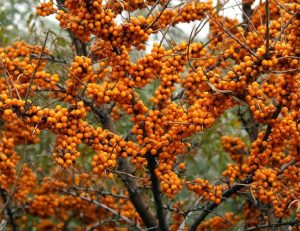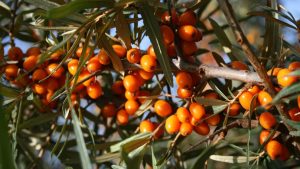Sea Buckthorn – Hippophae Raminoides


The Sea Buckthorn belongs to the Eleagnacee family: We are talking about a thorny shrub which has a lot of branches, It can reach a height of 6 metres, In the past, some people considered the Sea Buckthorn to be poisoneous: not by chance, the scientific botanical name (hippophae rhamnoides) refers to “cavallo” (hippos) e “uccido” (phao). However we should underline the fact that really the Sea Buckthorn is NOT poisoneous.
TERRAIN
The Sea Buckthorn is one of the most rustic plants that exist, and has no specific demands regarding the soil. It stands up well to humidity and drought. It prospers very well in poor soil, sandy or stony. You would do well to plant it in a sunny position, in order to have abundant fruit.
FLORA AND FRUIT
The Sea buckthorn is a hermaphrodite shrub: the plant doesn’t present male and female flowers at the same time, therefore to obtain fruit it is necessary to plant two or more examples together. The fruit grows grouped along the branches: the fruit looks like elongated olives, somewhat acid even though edible, and used specifically to prepare syrups. The harvest is at times problematic, because of the thorns which stretch out from the branches: This means it is an excellent “defense” when used to create hedges.
USE AND HEALTH GIVING PROPERTIS
Nowadays, the Sea Buckthorn is used for its richness in vitamin C, used phyto therapeutically: it’s estimated that a glass of extract from this fruit contains up to 33mg of ascorbic acid, the same quantity as found in a glass of fresh orange juice. It is therefore considered an excellent mineralizing tonic. The plant is also used to treat immune deficiency, in the prevention of infective diseases, in the case of lack of appetite and weakness.
The importance of the Sea Buckthorn doesn’t stop there: the plant can boast of its healing properties, anti-inflammatory capillary and anti-peroxdative properties, while the mother tincture of leaves and young branches works in the treatment of the early stages of enteritis.
POTTING PRUNING AND CULTIVATION
It is not necessary to pot, it’s enough to cut the low branches ( which die when not exposed to the sun) and the suckers, which could become infested. Water and fertilize only during the first year of planting.
Being a very robust shrub it’s not subject to parasites or disease. Moreover it tolerates atmospheric pollution and resists ice.
